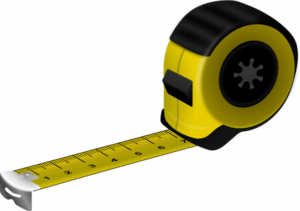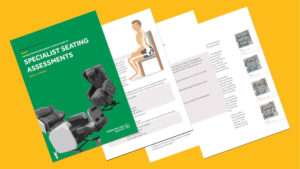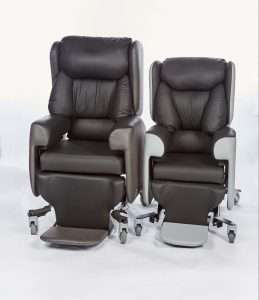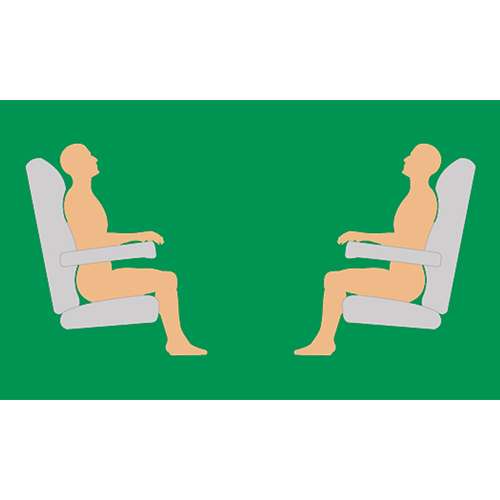When you’re specifying seating for petite people and people with dwarfism, you need to bear a few different things in mind to ensure that your client is getting the best possible solution.
Here are some things you need to consider when carrying out seating assessments for petite people, plus our recommendations for a suitable chair.
Jump straight to…
Seating height for people with dwarfism
The most crucial factor when specifying seating for short people or people with dwarfism is the seat height. Any standard-sized chair will be too high from the ground and won’t offer the right support.
If you get the wrong seat height, it could end up with the client being very uncomfortable and it could even lead to pressure sores around the buttocks or at the backs of their thighs/knees.
When you’re carrying out a seating assessment, make sure you measure the person’s leg length from the base of their foot to the back of their knee. In rise and recline chairs, the seat height can be specified as low as 13 inches (around 33cm).
For care chairs, it is possible to get the seat height down to around 14 inches (35cm). The Little Lento Care Chair has been specially designed to suit people under 5’2″, so it provides a lower seat height than most.

The seat height is crucial when you’re assessing someone with dwarfism.
Do you need any motors in the chair?
Some seating manufacturers simply don’t cater to clients with dwarfism because they struggle to fit motors into chairs that are a smaller size. But this doesn’t mean that it’s not possible.
Some manufacturers will tuck the motor away cleverly into the sides of the chair so that they can still function without getting in the way.
When you’ve carried out your seating assessment and have decided that the client will need a chair with motors, always make sure that the chair you choose can accommodate motors at a reduced seat height. If you’re struggling to find a chair manufacturer who can provide the right solution, get in touch with our team.
Armrest height measurements
Another key measurement you need to think about is the armrest height. Standard armrest height on an adult’s chair is around 7 inches (18cm); for people with dwarfism, it generally needs to be less than this.
Getting the right armrest height measurement will not only keep your client comfortable, but it will also ensure that they have the right support in their chair. It will also reduce the chance of any pressure injuries forming from ill-fitted seating.
For more information on how to measure for specialist seating, download our free eBook.

Our free Specialist Seating Assessments eBook is full of useful information that will help you prescribe seating for a range of different clients and medical conditions.
Other seating measurements for people with dwarfism
As with the seat and armrest height, other measurements of the chair should be checked and adapted to suit short people. The general size of the chair will be more compact, so you need to ensure that every inch is accounted for.
The backrest of the chair will need to be smaller, as will the seat depth. Always double-check the seat width needed when carrying out your assessment as this may be proportionally larger than your other measurements.

Lento and Little Lento side-by-side. You can see that Little Lento is more compact and far easier to size for someone with dwarfism
Seat height, depth, armrest height and leg length can all be adjusted without tools on the Little Lento. This means the care chair can be perfectly sized for petite individuals with dwarfism.
Choosing a backrest
As with any other seating assessment, you’ll need to look at the client’s positioning needs. This could include spinal conditions like scoliosis, kyphosis, and lordosis.
For specialist seating for petite users, you might need to consider spinal conditions and how they could possibly be supported by the chair. A waterfall backrest will give you more flexibility in where you place your support, whereas a backrest with more lateral support would be good for someone who leans heavily to one side.
Just make sure you’re noting down these details in your seating assessment so that you can specify the best chair possible. You should also consider if the person has any need for extra pressure relief or any other features you would include in a standard assessment.
Summary
When choosing the right specialist seating for petite people and those with dwarfism, we recommend that you always ensure you’ve got the right measurements — particularly for seat height! If your client wants a riser recliner chair, they will likely need a bespoke made-to-measure chair to suit their needs. Our team will be happy to help with specifying one. However, if your client needs a care chair then we recommend Little Lento. All measurements can be altered without tools and the chair was designed especially for people under 5’2″. So, it is the ideal chair for people with dwarfism.















